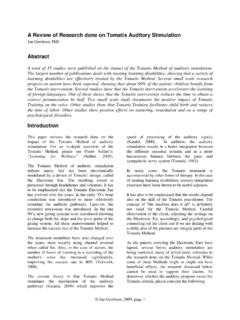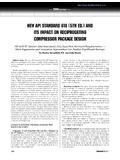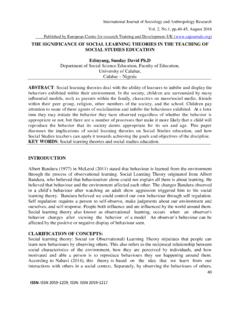Transcription of GCSE RELIGIOUS STUDIES 8062/2A - filestore.aqa.org.uk
1 SPECIMEN MATERIAL GCSE RELIGIOUS STUDIES 8062/2A PAPER 2A Mark scheme Specimen MARK SCHEME GCSE RELIGIOUS STUDIES A 8062/2A SPECIMEN Mark schemes are prepared by the Lead Assessment Writer and considered, together with the relevant questions, by a panel of subject teachers. This mark scheme includes any amendments made at the standardisation events which all associates participate in and is the scheme which was used by them in this examination. The standardisation process ensures that the mark scheme covers the students responses to questions and that every associate understands and applies it in the same correct way. As preparation for standardisation each associate analyses a number of students scripts. Alternative answers not already covered by the mark scheme are discussed and legislated for. If, after the standardisation process, associates encounter unusual answers which have not been raised they are required to refer these to the Lead Assessment Writer.
2 It must be stressed that a mark scheme is a working document, in many cases further developed and expanded on the basis of students reactions to a particular paper. Assumptions about future mark schemes on the basis of one year s document should be avoided; whilst the guiding principles of assessment remain constant, details will change, depending on the content of a particular examination paper. Further copies of this mark scheme are available from 2 MARK SCHEME GCSE RELIGIOUS STUDIES A 8062/2A SPECIMEN Level of response marking instructions Level of response mark schemes are broken down into levels, each of which has a descriptor. The descriptor for the level shows the average performance for the level. There are marks in each level. Before you apply the mark scheme to a student s answer read through the answer and annotate it (as instructed) to show the qualities that are being looked for. You can then apply the mark scheme. Step 1 Determine a level Start at the lowest level of the mark scheme and use it as a ladder to see whether the answer meets the descriptor for that level.
3 The descriptor for the level indicates the different qualities that might be seen in the student s answer for that level. If it meets the lowest level then go to the next one and decide if it meets this level, and so on, until you have a match between the level descriptor and the answer. With practice and familiarity you will find that for better answers you will be able to quickly skip through the lower levels of the mark scheme. When assigning a level you should look at the overall quality of the answer and not look to pick holes in small and specific parts of the answer where the student has not performed quite as well as the rest. If the answer covers different aspects of different levels of the mark scheme you should use a best fit approach for defining the level and then use the variability of the response to help decide the mark within the level, ie if the response is predominantly level 3 with a small amount of level 4 material it would be placed in level 3 but be awarded a mark near the top of the level because of the level 4 content.
4 Step 2 Determine a mark Once you have assigned a level you need to decide on the mark. The descriptors on how to allocate marks can help with this. The exemplar materials used during standardisation will help. There will be an answer in the standardising materials which will correspond with each level of the mark scheme. This answer will have been awarded a mark by the Lead Examiner. You can compare the student s answer with the example to determine if it is the same standard, better or worse than the example. You can then use this to allocate a mark for the answer based on the Lead Examiner s mark on the example. You may well need to read back through the answer as you apply the mark scheme to clarify points and assure yourself that the level and the mark are appropriate. Indicative content in the mark scheme is provided as a guide for examiners. It is not intended to be exhaustive and you must credit other valid points. Students do not have to cover all of the points mentioned in the Indicative content to reach the highest level of the mark scheme.
5 An answer which contains nothing of relevance to the question must be awarded no marks. 3 MARK SCHEME GCSE RELIGIOUS STUDIES A 8062/2A SPECIMEN Levels of response marking In GCSE RELIGIOUS STUDIES , differentiation is largely achieved by outcome on the basis of students responses. To facilitate this, levels of response marking has been devised for many questions. Levels of response marking requires a quite different approach from the examiner than the traditional point for point marking. It is essential that the whole response is read and then allocated to the level it best fits. If a student demonstrates knowledge, understanding and/or evaluation at a certain level, he/she must be credited at that level. Length of response or literary ability should not be confused with genuine RELIGIOUS STUDIES skills. For example, a short answer which shows a high level of conceptual ability must be credited at that level. (If there is a band of marks allocated to a level, discrimination should be made with reference to the development of the answer.)
6 Levels are tied to specific skills. Examiners should refer to the stated assessment target objective of a question (see mark scheme) when there is any doubt as to the relevance of a student s response. Levels of response mark schemes include either examples of possible students responses or material which they might use. These are intended as a guide only. It is anticipated that students will produce a wide range of responses to each question. It is a feature of levels of response mark schemes that examiners are prepared to reward fully, responses which are obviously valid and of high ability but do not conform exactly to the requirements of a particular level. This should only be necessary occasionally and where this occurs examiners must indicate, by a brief written explanation, why their assessment does not conform to the levels of response laid down in the mark scheme. Such scripts should be referred to the Principal Examiner. In questions where credit can be given to the development of a point, those developments can take the form of: Example or evidence Reference to different views Detailed information.
7 4 MARK SCHEME GCSE RELIGIOUS STUDIES A 8062/2A SPECIMEN Spelling, punctuation and grammar (SPaG) Spelling, punctuation and grammar will be assessed in 12-mark questions. Spelling, punctuation and grammar (SPaG) will be assessed against the following criteria: Level Performance descriptor Marks awarded High performance Learners spell and punctuate with consistent accuracy Learners use rules of grammar with effective control of meaning overall Learners use a wide range of specialist terms as appropriate 3 Intermediate performance Learners spell and punctuate with considerable accuracy Learners use rules of grammar with general control of meaning overall Learners use a good range of specialist terms as appropriate 2 Threshold performance Learners spell and punctuate with reasonable accuracy Learners use rules of grammar with some control of meaning and any errors do not significantly hinder meaning overall Learners use a limited range of specialist terms as appropriate 1 No marks awarded The learner writes nothing The learner s response does not relate to the question The learner s achievement in SPaG does not reach the threshold performance level.
8 For example errors in spelling, punctuation and grammar severely hinder meaning 0 5 MARK SCHEME GCSE RELIGIOUS STUDIES A 8062/2A SPECIMEN 01 Theme A: relationships and families Qu Part Marking guidance Total marks 01 1 Which one of the following best expresses the RELIGIOUS view that one purpose of marriage is to have children? A Procreation. B Contraception. C Stability. D Polygamy. Target: AO1:1 Demonstrate knowledge and understanding of religion and belief, including beliefs, practices and sources of authority. Answer: A Procreation. 1 01 2 Give two RELIGIOUS beliefs about the nature of the family. Target: AO1:1 Demonstrate knowledge and understanding of religion and belief, including beliefs, practices and sources of authority. One mark for each of two correct points. Should be based on the marriage of two people male and female/extended family/ordained by God or commanded in scripture/a duty to marry/a vocation for some believers only.
9 2 6 MARK SCHEME GCSE RELIGIOUS STUDIES A 8062/2A SPECIMEN 01 3 Explain two contrasting beliefs in contemporary British society about the use of artificial contraception within marriage. In your answer you should refer to the main RELIGIOUS tradition of Great Britain and one or more other RELIGIOUS traditions. Target: AO1:3 Demonstrate knowledge and understanding of religion and belief, including similarities and differences within and/or between religions and beliefs First contrasting belief Simple explanation of a relevant and accurate contrast 1 mark Detailed explanation of a relevant and accurate contrast 2 marks Second contrasting belief Simple explanation of a relevant and accurate contrast 1 mark Detailed explanation of a relevant and accurate contrast 2 marks Students may include some of the following points, but all other relevant points must be credited: Buddhism The Moral Precept of ahimsa (non-harming) means that no living being should be harmed.
10 Since rebirth takes place at conception, no methods which cause an abortion should be used, such as the coil or morning after pill. Other methods are acceptable. The principle of Right Intention means that using contraception to prevent suffering, such as risk to a mother s health is acceptable but using it for selfish reasons is wrong. The underlying philosophy of the Moral Precepts is the interconnectedness and value of all life. Christianity There are contrasting views within Christianity. Orthodox and Roman Catholics teach artificial contraception within marriage is wrong- against natural law and purpose of marriage; might encourage infidelity. Every sexual act should have the possibility of creating new life (Humanae Vitae, 1968). Other Christians accept its use in family planning for health, financial and other personal reasons. The Church of England approved the use of artificial contraception at the Lambeth Conference in 1930: The Conference agrees that other methods may be used, provided that this is done in the light of Christian principles.















